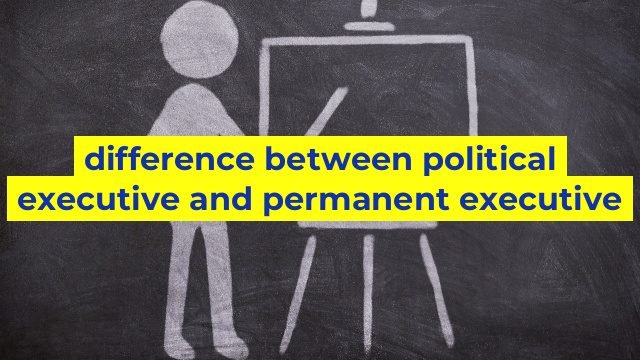The Difference Between Political Executive and Permanent Executive
When it comes to government structures, one key element is the difference between the political executive and the permanent executive. These are two distinct entities with different responsibilities and roles within government. In this article, we’ll explore the key differences between these two types of executives.
Political Executive
The political executive is the part of government that is responsible for setting the political agenda and implementing policies. This includes elected officials, such as presidents, prime ministers, governors, mayors, and other political appointees. They are responsible for driving political change, crafting legislation, and implementing policies through the bureaucracy.
The political executive includes the head of state, head of government, cabinet ministers, and other political appointees. These individuals have a specific mandate to institute political change and ensure that the government’s agenda is executed effectively.
One key factor that separates the political executive from the permanent executive is that they are elected or appointed, meaning that their terms are limited. Once their term is up, the political executive will be replaced by a new appointee, who may have a different political agenda.
Permanent Executive
The permanent executive, on the other hand, is the part of the government responsible for implementing policies on a day-to-day basis. They are the career bureaucrats who work within government agencies and departments that ensure the smooth functioning of government operations.
Permanent executives are not appointed by politicians but are instead recruited through a competitive and rigorous hiring process. They have no political affiliation and are expected to act in the best interest of the country.
Some examples of permanent executives include civil servants, police officers, military officials, and other government employees. These individuals are responsible for implementing government policies and programs, as well as ensuring that laws and regulations are enforced.
The Key Differences
The key differences between the political executive and permanent executive can be summarized as follows:
- The political executive is responsible for setting a political agenda, whereas the permanent executive is responsible for implementing policies on a day-to-day basis.
- The political executive is elected or appointed, whereas the permanent executive is recruited through a competitive process and has a more long-term tenure.
- The political executive may have a specific political agenda, whereas the permanent executive is expected to act in the best interest of the country.
Conclusion
Understanding the difference between the political executive and permanent executive is crucial for understanding how government works. These two entities play different roles but work together to ensure that the government serves its citizens effectively. By understanding their responsibilities, you can gain a better understanding of how government policies are implemented and how political change occurs.
Table difference between political executive and permanent executive
| Political Executive | Permanent Executive |
|---|---|
| The political executive is the set of individuals who have been elected or appointed to positions of power within a government. They are responsible for setting policy and making decisions that affect the nation. | The permanent executive is made up of individuals who have been appointed to permanent positions within the government. They are responsible for implementing policies and carrying out the day-to-day activities of the government. |
| The political executive is accountable to voters and must seek their approval through elections. They may also be subject to impeachment or other forms of removal from office if they violate the law or fail to uphold their duties. | The permanent executive is accountable to the political executive and must follow their orders and directives. They may be subject to disciplinary action or termination if they fail to carry out their duties or violate the law. |
| The political executive is typically composed of elected officials, such as the president, prime minister, or members of Congress. They may be affiliated with a political party or have independent political views. | The permanent executive is composed of civil servants, bureaucrats, and other government employees who have been hired through a merit-based system. They are expected to be politically neutral and impartial in carrying out their duties. |

